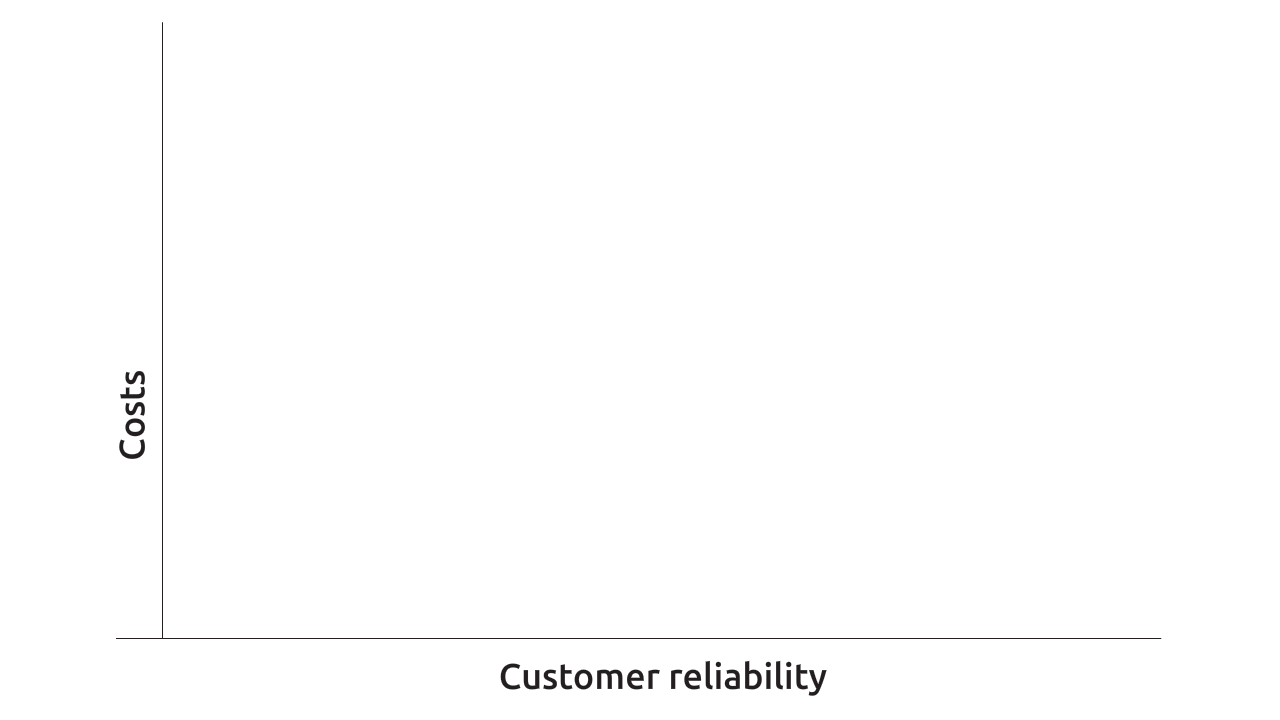SUMMARY
It will become increasingly, possibly prohibitively costly to pursue resource adequacy without adequate consideration for the operational flexibility of traditional supply options or for non-traditional options for matching supply to demand (particularly implicit electricity demand flexibility). New, more dynamic methods of assessing adequacy are needed. Approaches to incentivizing resource investment should become more adaptive to rapidly changing technology and service options, with the objective of optimizing the delivered cost of electricity over time rather than simply reducing the investment costs of individual resources.
WHAT
Delivering reliable energy services at least cost
HOW
Establish larger geographies and better metrics; empower flexible consumers
WHO
ACER, NRAs, TSOs, DSOs
WHEN
Immediately
Resource adequacy addresses whether the existing and anticipated supply and supply-equivalent resources available to the grid can ensure, to an acceptable standard, supply of energy to serve expected system load. There are three broad underlying questions to be addressed: What is adequate? How is the adequacy of the resource portfolio assessed? And how does the market sustain investment in an adequate level of resources?
Establishing the standard for adequacy is the essential first step. More supply virtually always equals more reliability, but is the gain large enough to justify the cost? Establishing a standard begins with estimating the cost of supply interruptions to consumers in the value of lost energy services or value of lost loadValue of loss load The value consumers assign to unsupplied energy. (VOLL). That value is then combined with the assumed cost of adding an incremental resource to the grid or the cost of new entrantcost of new entrant The total annual net revenue per unit of capacity ("net" meaning excluding recovery of operating costs) that the most economic new capacity resource would need to receive over its economic lifetime in order to recover its capital costs and annual fixed costs. This aligns with ACER's definition of "fixed CONE". (CONE) to determine the expected incidence of supply-related forced curtailments beyond which incremental improvement would cost more than it’s worth to consumers. This then provides the basis for setting a standard, which can be expressed in the number of expected hours or events of curtailmentcurtailment The reduction of power output of specific generators by the system operator on grounds of maintaining grid stability and system safety, often in exchange for compensation. or loss of load expectationloss of load expectation The number of hours per year in which, over the long-term, it is expected that supply will not meet demand. This metric is often used to define a reliability standard. (LOLE) or in the amount of energy demand that will not be met or energy not servedenergy not served The amount of electricity demand - measured in MWh – that is expected not to be met by generation in a given year. Metrics often used for define reliability standard. (ENS) over some period of time. Follow this link to learn more about the reliability standards of various Member States.
Optimal adequacy is the optimum trade-off between new investment costs and ENS costs

Source: European Commission. (2015). Identification of Appropriate Generation and System Adequacy Standards for the Internal Electricity Market.
The existing and expected portfolio of resources can then be assessed for its ability to meet that standard using probabilistic analyses. This is based on simulations of variables, such as how different kinds of resources have historically performed under different conditions, the likelihood of different weather scenarios and how the amount and shape of demand is expected to develop going forward. Such simulations must reflect the reality that power flows on a large electric grid do not recognize political boundaries. It has long been recognized that resource adequacy is most cost effectively achieved by cooperation across the largest practical geographic area, and as the resource base changes, this will only become more important. As illustrated by events over two days in California in August 2020, the risks for supply shortfall are changing as the nature of the resource portfolio changes, with the greatest risks occurring at times other than when demand is at its highest. Assessment methodologies must adapt as needed to reflect this new reality.
This all leads to the critical question of whether and how the market will support the investment in resources needed to comply with the standard. Much has been written about the money ‘missing’ from markets to pay for the extra resources needed to ensure resource adequacy. In theory there is no such thing as missing money, but because electricity consumers have historically been unable or unwilling to vary their consumption themselves based on their VOLL, it is valid, at least for the time being, to ask how the market design should compensate as needed. This involves administrative interventions of varying degrees of intensity.
The least invasive approach taken in some markets relies on the role of the system operator, acting as proxy for consumers’ demand for reliability, in maintaining reserves to supply different balancing services needed to comply with the reliability standard. It involves various combinations of co-optimisation (combining the demand for energy and the demand for reserves to set a price for energy that optimises the allocation of resources between them) and administrative reserve scarcity pricing (setting an energy price adder that reflects the increased risk of a supply shortfall when the demand for energy causes reserves to fall below the required level; see Scarcity Pricing factsheet).
The resulting wholesale market price and volume risks incentivise buyers and sellers to support needed investment through bilateral contracting and trading in financial and physical hedge products. An additional measure of confidence can be provided by a backstop mechanism that provides for direct intervention by the system administrator in the event of an imminent unresolved shortfall in resource commitments.
Other regions take more invasive approaches, based on setting a binding level of planning reserves at some future date and enforcing compliance through various forms of centrally administered forward procurement processes. The commitments awarded under these mechanisms can be for as little as six months or as long as 15 years. This approach presumes either that it is more costly to rely on market actors to deliver the desired margin or that a less prescriptive approach cannot or will not deliver the desired margin on its own. This can become self-perpetuating, with binding targets often set well in excess of what an efficient market would ever deliver based on net value to consumers.
Even where planning margins may be properly set, it is debatable whether administratively allocated long-term commitments are more cost effective than a portfolio of market-driven forward market options. Such long-term commitments, guaranteed by consumers or taxpayers, can reduce investment costs on a resource-by-resource basis by shifting volume and price risks away from investors. But they can also lock consumers or taxpayers into investment choices years into the future. The longer the terms of the commitments, the more significant the risk that the overall final cost of energy may be higher, not lower, due to overprocurement, ill-advised investment choices, exclusion of lower-cost alternatives or premature obsolescence (see Thriving Forward Markets factsheet).
This question of the optimal mix of investment risk management options is of particular concern in the energy transition, which is giving rise to historic levels of uncertainty about technology and service innovation, the future shape of demand for electricity and the value of adaptability to both. Both approaches outlined above — the less prescriptive approach, combining co-optimisation and administrative scarcity pricing, and the more prescriptive approach of centrally administered long-term resource procurement — can be described as capacity-based market interventions. But they can lead to very different outcomes, both in the opportunities they provide for nontraditional or not-yet-apparent alternatives and in the extent to which the power system can adapt to rapidly changing circumstances. As we proceed through the energy transition, where market design falls on this spectrum will determine whether or not adequacy is assured in a cost-effective, sustainable manner.
Key Recommendations
- Assess resource adequacy over the largest practical geographic footprint such that all political jurisdictions within that footprint are assured an equal level of supply security.
- Establish an economic standard for resource adequacy that reflects the more dynamic nature of supply risk, incorporating a transparent and reasonable degree of aversion to downside scenarios.
- Adopt administrative measures in the energy market to optimise its ability to drive efficient investment decisions, both directly and through the stimulation of forward risk management activity by market buyers and sellers (see Locational Marginal Pricing and Thriving Forward Markets factsheets).
- Maximise the extent to which the value of flexible resources is expressed in the level and volatility of short-term energy market prices, given that many new, innovative, nontraditional, especially demand-side alternatives for meeting resource adequacy targets most cost effectively will rely largely or entirely on energy price incentives.
- Employ administrative forward procurement of capacity only when there is a projected shortfall of resources relative to an economic planning margin; limit the commitment periods to the minimum length necessary to strike an optimal balance between initial capital cost and future optionality for consumers.
- Maximise beneficial market entry by ensuring timely exit of uneconomic resources (see Accelerated Overcapacity Exit factsheet); avoid subsidising surplus capacity through enforcement of uneconomic reserve margins.
References and Further Reading
- Hogan, M. (2017). Follow the missing money: Ensuring reliability at least cost to consumers in the transition to a low-carbon power system. Electricity Journal, 30(1), 55-61.
- Agency for the Cooperation of Energy Regulators. (2020). ACER-CEER Market Monitoring Report (MMR) 2019. Volume 1: Electricity Wholesale Markets Volume.
- European Commission. (2015). Identification of Appropriate Generation and System Adequacy Standards for the Internal Electricity Market.
- Published:
- Last modified: August 13, 2024

 Quick guide on how to use this website:
Quick guide on how to use this website: